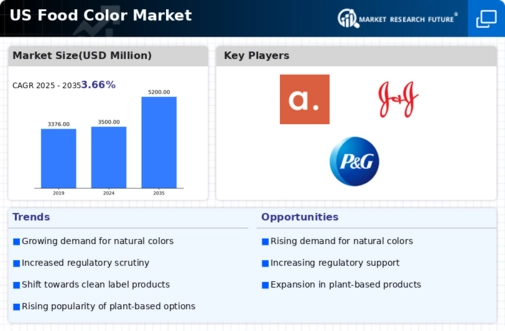The food color market is currently characterized by a dynamic competitive landscape, driven by increasing consumer demand for natural and clean-label products. Key players are actively innovating and expanding their portfolios to meet these evolving preferences. Companies such as Sensient Technologies Corporation (US), Givaudan (US), and Chr. Hansen (US) are at the forefront, focusing on product innovation and sustainability initiatives. Sensient Technologies Corporation (US) emphasizes its commitment to natural colors, leveraging its extensive R&D capabilities to develop innovative solutions that cater to health-conscious consumers. Meanwhile, Givaudan (US) has been enhancing its digital transformation efforts, integrating advanced technologies to streamline operations and improve customer engagement. Chr. Hansen (US) is also notable for its strategic partnerships aimed at expanding its market reach and enhancing its product offerings, thereby shaping a competitive environment that prioritizes innovation and sustainability.
In terms of business tactics, companies are increasingly localizing manufacturing and optimizing supply chains to enhance efficiency and responsiveness to market demands. The competitive structure of the food color market appears moderately fragmented, with several key players exerting considerable influence. This fragmentation allows for a diverse range of products and innovations, while also fostering competition among established and emerging companies.
In November 2025, Sensient Technologies Corporation (US) announced the launch of a new line of plant-based colorants designed to meet the growing demand for natural ingredients in food products. This strategic move not only reinforces Sensient's commitment to sustainability but also positions the company to capture a larger share of the market as consumers increasingly seek out clean-label options. The introduction of these colorants is expected to enhance Sensient's competitive edge by aligning with consumer trends towards healthier and more transparent food choices.
In October 2025, Givaudan (US) unveiled a new digital platform aimed at enhancing customer interaction and streamlining the product development process. This initiative reflects Givaudan's focus on digitalization as a means to improve operational efficiency and foster closer relationships with clients. By leveraging technology, Givaudan is likely to enhance its responsiveness to market trends and customer needs, thereby solidifying its position as a leader in the food color sector.
In September 2025, Chr. Hansen (US) entered into a strategic partnership with a leading organic food manufacturer to co-develop innovative color solutions tailored for organic products. This collaboration underscores Chr. Hansen's strategy of aligning with industry leaders to expand its product offerings and market presence. Such partnerships are indicative of a broader trend in the market, where collaboration is becoming essential for driving innovation and meeting consumer demands.
As of December 2025, the food color market is witnessing trends that emphasize digitalization, sustainability, and the integration of AI technologies. Strategic alliances among key players are increasingly shaping the competitive landscape, fostering innovation and enhancing product offerings. The shift from price-based competition to a focus on technological advancement and supply chain reliability is evident, suggesting that future competitive differentiation will hinge on the ability to innovate and respond to consumer preferences effectively.














Leave a Comment